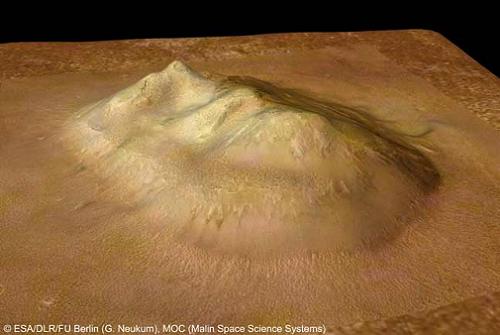New images from the Mars Express satellite of the European space hazard will confirm to many that the formation is natural, while no doubt also offering tantalizing hints to others that the structure is the work of an ancient intelligent culture.

NASA started this back in 1976 by publishing an interesting image of a mountain on the surface of Mars, along with a caption describing it as having what appear to be eyes and nostrils. Thirty years later, the face on Mars still inspires myths and conspiracy theories.
New images from the Mars Express satellite of the European space hazard will confirm to many that the formation is natural, while no doubt also offering tantalizing hints to others that the structure is the work of an ancient intelligent culture.
The spacecraft's high-resolution stereo camera provides data that the researchers turn into perspective photographs with the addition of color, which simulate the image as if it were flying over the area in the spacecraft. The data was obtained in July and the images were recently released (September)
"They provide not only a new and detailed view of the famous area for lovers of space myths all over the world, but also an impressive close-up of an area that is a magnet for planetary geologists, proving once again the high skills of the Mars Express camera", says Agustin Chicaro , a scientist at the European Space Agency (ESA) on the Mars Express project.
The structure known as "The Face", together with another structure that looks like a skull and other pyramid-like hills in the vicinity, are located in an area called "Sidonia" in the Terra Arabia region ("Land of Arabia"). It is a transitional area between the southern mountains and the northern plain. The area contains wide valleys and mounds of ancient remains, known as "mountain blocks", and they are characterized by many shapes and sizes.
The mass of mountains that formed the famous "face" was first seen in a photo taken on July 25, 1976 by NASA's Viking 1 satellite. NASA scientists thought it resembled a human head, and even though they knew it was just an illusion, the Jet Propulsion Laboratory released the image with the following caption.
"The dotted appearance of the image is the result of a lack of data, a condition known as erroneous bits, caused by problems in the data traffic of the image from Mars to the Earth." Erroneous bits were mostly the reason why the sunken parts on top of the stone reflected like eyes or nostrils and made it look like a human face near the center of the image. Shadows on top of the stone give the illusion of a nose and mouth. Planetary geologists attribute the development of the structure to completely natural processes.
A strong myth developed and held the opinion that the face is an artificial structure that was built by an ancient culture. The pyramids in the same area - which are also interesting and attractive stone structures - only added fuel to the myth. Last year, a study helped to understand why: people see faces even when they are not - on Mars or in cloud structures - because we have overlearned to recognize the human face everywhere.
Additional photos of the face taken recently show that from other angles, the stone does not look like a face at all.
ESA scientists are interested in the geology of the area. Landslides and wide areas of ruined villages show how the rather eroded surface has changed over time and allow them to learn the truth about the past on Mars.
